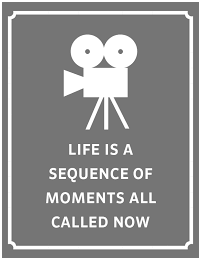This is traditionally a time for New Year’s Resolutions, Year-end Reconciliations, and Thoughtful Re-evaluation. In that vein, I have taken some of the most common themes trolling the Internet for creating resolutions that stick and the applications of these theories to 2015 marketing plans and trends. Here are the three recommendations that this post will address in creating “New Year’s Resolutions that Stick:”
- Once in a Lifetime. Not!
- Live in the Moment.
- Profits, Prosperity, and Balance.
Once in a Lifetime—Not!
Leave it to O Magazine to find a tidbit on Littlewood’s Law that re-calculates “once in a lifetime” to “one million times per month.”
per month.”
“If you break your day into two-second chunks, in a month’s time you will have experienced about a million [two-second chunks]–or a million opportunities for something wild to happen. Most people think a one-in-a-million chance is unlikely. But this principle suggests that with enough chances, crazy coincidences are likely to occur.”
[O Magazine attributes this tidbit to Steven Strogatz, PhD, Professor of Applied Mathematics at Cornell University. Also interesting is the layman explanation for the Law of Large Numbers.]
Implication for New Year’s Resolutions: Every step we take toward the achievement of our goal increases the likelihood of attaining the goal.
Live in the Moment.
“The happiness of over 18,000 people worldwide has been predicted by a mathematical equation developed by researchers at UCL, with results showing that moment-to-moment happiness reflects not just how well things are going, but whether things are going better than expected.” Hence, when you experience a series of rewards vis-à-vis your expectations, moment to moment happiness is elevated. And in turn, our optimism toward future expectations is elevated. Believing that our happiness changes from moment to moment reinforces Littlewood’s Law.
Implication for New Year’s Resolutions: Small changes lead to big impacts. Don’t be a super-hero—create the environment that will keep you feeling positive. “I’ll walk 20 minutes each day vs. I will get more exercise.” Have a bottle of water, some mint tea, or a pack of almonds nearby for those times, in-between meals, when you think you are hungry. Small, positive actions that can keep us optimistic.
Profits, Prosperity, and Balance.
 The desire for purpose, calling, or self-fulfillment is not new. However, in today’s society which allows 24/7 connectivity, availability and choice…the boundaries between our work and personal lives is often non-existent. The concept of Work─Life balance has become a concept of Work─Life integration. The premise of seeing one’s act of labor as fulfilling and satisfying─regardless of the role one plays in the world of work─provides the consistency that allows us to thrive in everything that we do.
The desire for purpose, calling, or self-fulfillment is not new. However, in today’s society which allows 24/7 connectivity, availability and choice…the boundaries between our work and personal lives is often non-existent. The concept of Work─Life balance has become a concept of Work─Life integration. The premise of seeing one’s act of labor as fulfilling and satisfying─regardless of the role one plays in the world of work─provides the consistency that allows us to thrive in everything that we do.
Implication for New Year’s Resolutions: Taking Littlewood’s Law and the UCLA study one step further, we can create consistent opportunities for positive personal growth by ensuring that our work and our play are in keeping with the things we value and see as fulfilling.
Implications of These New Year’s Resolutions for 2015 Marketing Plans
The three selected theories on attaining our 2015 New Year’s Resolutions have a common theme: Personalized Rewards and Incentives. Here are few examples where this is applied:
Weight Watchers added new personalized offers during the 2014 Holiday Season. Certified coaches are available 24/7, and individualized weight management plans including phone, text, and email support further supplement the in person meetings. Moment-to-moment supports have been created.
Fair Splitting: Real time tools, using m-payments, can split these costs for products, services, and experiences among consumers. The instant gratification and cost savings may be able to turn the moment of payment (a necessary evil) into a moment of consumer pleasure.
“In June 2014, Russian bank Alfa-Bank launched a special account that rewards customers for taking physical exercise. Users connect their fitness tracker to the service, and for every step taken, funds from their existing account are transferred into the savings account, which pays a higher rate of interest than normally available.”
[See Trend Briefing for details and more examples.]
Changing Patterns of Work and Employment: Four examples highlight the range of options that are linking consumer choice with social values.
- Edelman has a social purpose practice based on the premise that “individuals no longer desire to be viewed as just ‘consumers,’ but as citizens; they want to engage with brands and corporations to address social issues.”
- Encore.org focuses on “those in and beyond midlife represent a powerful source of talent with the accumulated skills, experience, and wisdom to tackle some of society’s most urgent challenges.”
- Jacob Morgan’s infographic simplifies the evolving view of how we work, lead, and grow companies.
- Aaron Hurst’s Purpose Economy looks at community-commitment as the game changer in one’s holistic efforts toward personal growth and impact.
The list could go on. For me, the interwoven themes in creating New Year’s Resolutions and 2015 Marketing Plans and Programs are:
- Identify small interim steps toward the desired goals.
- Celebrate small wins.
- Repeat.
May we all enjoy a healthy, happy, and productive 2015!
This article was syndicated from Business 2 Community: Resolutions For Your 2015 Marketing Plans
More Sales & Marketing articles from Business 2 Community:
- Why SEO Is All About Having Good Content
- How to Find Great Content? The Ultimate Guide to Content Curation
- How To Deal With Angry, Frustrated Or Complaining Customers On Social Media (And Not Let It Affect Your Brand)
- Is 2015 The Year Of Content Marketing?
- 2015 B2B Marketing Strategies – What You Need and How To Do It!




